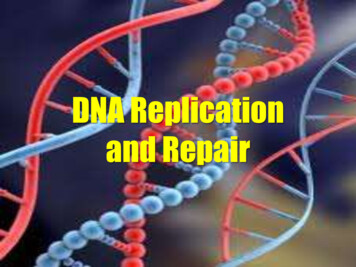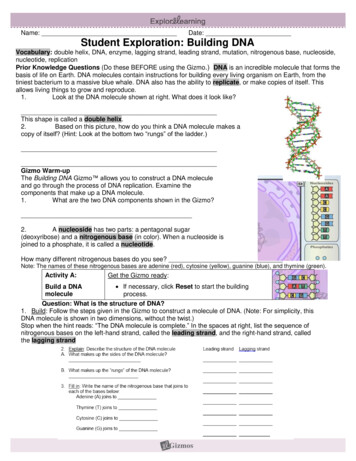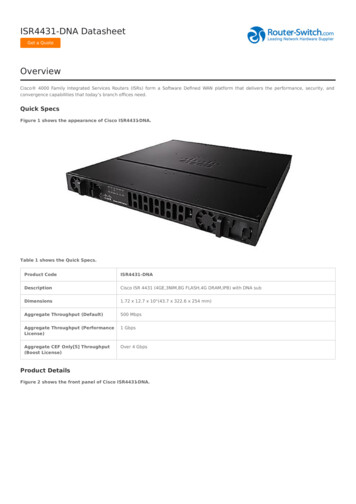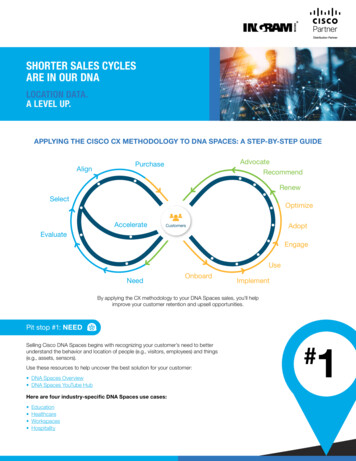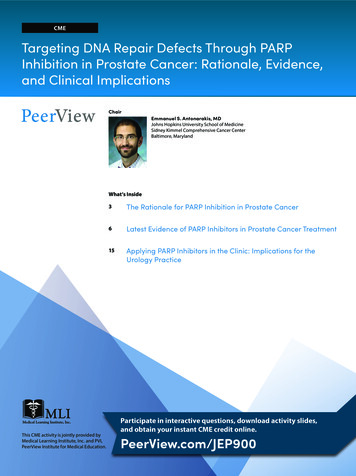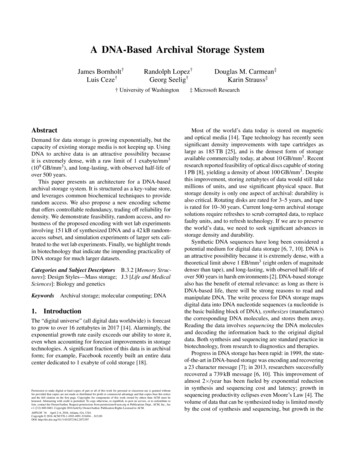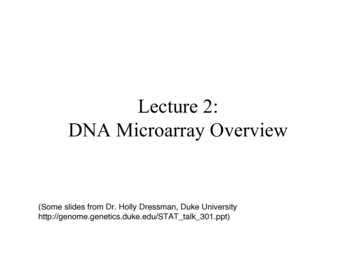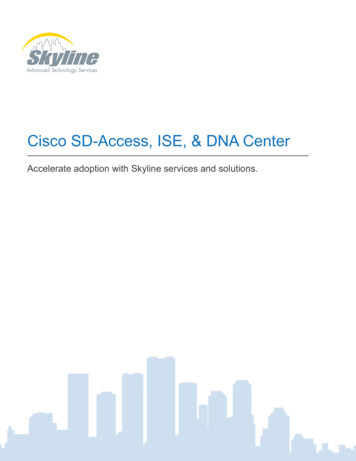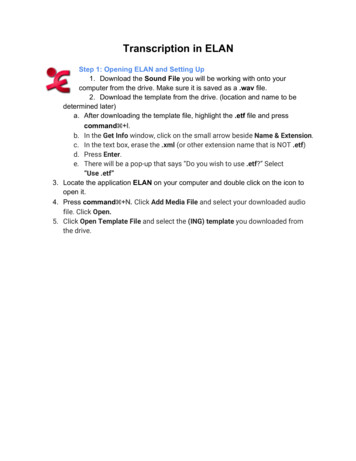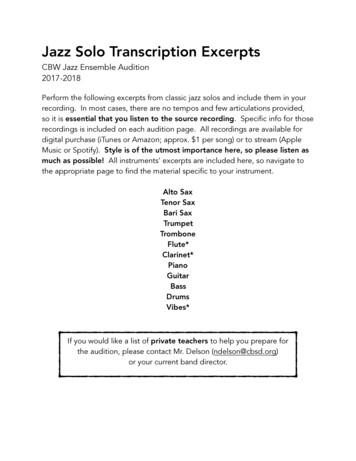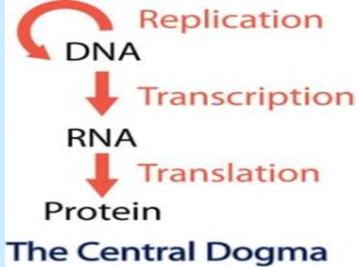
Transcription
1
DNA Replication--- transcription--- translation DNA is replicated in the nucleus. DNA is transcribed into RNA in thenucleus RNA is translated to protein in thecytoplasm2
Why are you different fromother people?3
4
5
6
7
8
9
Vocabulary Words RNA polymerase – enzymethat binds to DNA andseparates the DNA strandsduring transcription. Intron – sequence of DNA thatis not involved in coding for aprotein. Exon – sequence of DNA thatis involved in coding for aprotein.
DNAReplication--- transcription--- translationTranscription- The process of making RNAmolecules by copying part ofa DNA nucleotide sequence.- Production of mRNA copy ofthe DNA gene- Uracil replaces Thymine.- At the end of transcription:mRNA carries the geneticinformation out of the nucleusinto the cytoplasm where itattaches to a ribosome andtranslation begins
Steps of Transcription1. RNA polymerase separates the DNAstrands.2. Bases in RNA nucleotides pair upwith corresponding DNA bases.3. RNA is processed by removingintrons and splicing exons backtogether to form the final mRNA.12
What is RNA editing?The DNA of eukaryotic genescontain sequences of nucleotides,called introns, that are notinvolved in coding proteins. The DNA sequences that code forproteins are called exons. When the RNA molecules areformed, both the introns andexons are copied from the DNA. However, introns are cut out of RNA moleculeswhile they are still in the nucleus. The remaining exons are then spliced backtogether to form the final mRNA.
How does transcriptionwork?A certain gene has the following sequenceof nucleotides. From left to right, writethe sequence of the mRNA moleculetranscribed from this gene.DNAmRNAG A C A A GTC CAC AA TC
ReplicationTranscriptionTranslation15
16
17
Genetic code:instructions need to convert DNA into proteinsCodon- 3 consecutive mRNA nucleotidesAnticodon- unit made up of three nucleotides thatcorrespond to the three bases of the codon onthe mRNA
Vocabulary Words Amino acid – building block, or monomer,of all proteins. Ribosome – organelle in the cell that is incharge of producing proteins Polypeptide chain – a group of amino acidsjoined together that form proteins
DNAReplication--- transcription--- translationTranslation base pair sequence andturning it into an aminoacid sequence. Each 3 bases code forone amino acid (codon) The process buildingan amino acid bymatching codons inmRNA to anticodonsof tRNA Synthesis of proteinby ribosomesAt the end of translation:amino acid strand is releasedfrom the ribosome andfolded into a protein
What do these codons have to dowith proteins? Each codonrepresents anamino acid that willeventually form aprotein that is usedwithin a cell. Proteins are madeup of hundreds ofamino acids in aspecific sequence. When they get outof order a mutationoccurs.Long stringof aminoacids willform
Proteins Protein: sequence of Amino acids put together– Molecules that runs life (Does all the workof life)22
How are proteins made?DNA serve as atemplate to RNApolymerase.2. RNA polymerasecreates a mRNAmolecule.3. mRNA enterscytoplasm and bindsto a ribosome.4. tRNA brings oneamino acid at atime.5. New amino acids areadded to thepolypeptide chainuntil stop codon.1.
How does a cell interpret DNA? Consider the followingRNA sequence:5’UCGCACGGU 3’This sequence will be readthree bases at a time as:UCG – CAC – GGU The codons represent thefollowing amino-acids.Serine – Histidine – Glycine
How to read a codon tableUsed in protein synthesis fortranslating the mRNA code into aminoacid sequence.
DO NOW1. Geta piece of notebook paper.2. Explain the basic process of transcription andtranslation.DNATRANSCRIPTIONnucleusRNA lasmribosometRNAamino acidpolypeptide chaincodonrRNAanticodonmRNA
1st Step - Copy2nd Step- Rewrite3rd Step- Change28
Summary:DNAReplication: Make duplicateDNATranscription: Make mRNAfrom DNATranslation:Make protein
How does transcription works?DNAtemplatestrand3 5 A CCT G GA A A CCGA GTTGCT CAT T G5 3 DNAmoleculeGene 1TRANSCRIPTIONmRNA5 U G GTRANSLATIONProteinU UU GG CU CAGene 23 CodonTrpAmino acidPheGlySerGene 3
ReplicationTranscriptionTranslation31
Amino AcidCodons Every three base pairs is a Codon forone amino acid. The order of the amino acids formspolypeptides which fold into proteins.
20 amino acidsDNA sequence:TAC GGA CAT AAC ACC TGC ATCmRNA sequence: AUG CCU GUA UUG UGG ACG UAG
34
CopiesRewrites Builds
Look at the figure below: Whatstructure does this figure show? A. DNAB. RNA C. Protein D Amino Acid
A. CytoplasmB. NucleusC. RibosomeD. Cell Membrane
Which of the following carries amino acids to thesite of protein synthesis?A. mRNAB. rRNAC. tRNAD. nRNA
A diagram of a cellular process is shown below.Which of the following identifies the process shown atpoint Z?A. TranslationB. TranslocationC. ReplicationD. Transcription
The sequence of DNA below is part of a gene.How many amino acids are coded for by thissegment?5' ATCAGCGCTGGC 3‘A. 4B. 8C. 12D. 2040
Four different segments of a DNA molecule are represented below.There is an error in the DNA in which molecule?A. segment 1 onlyB. segment 3 onlyC. segment 2 and 3D. segment 2 and 441
Which of the following would most likely causea mutation?A. the placement of ribosomes on theendoplasmic reticulumB. the insertion of a nucleotide into DNAC. the movement of transfer RNA out of thenucleusD. the release of messenger RNA from DNA42
During transcription the DNA base sequence is transcribed into a complimentary mRNAsequence. A codon table like the one shown below lists the amino acids coded for byparticular triads of mRNA bases. A segment of DNA has undergone a mutation in whichone nucleotide has been changed. The original sequence was ACG and the newsequence is ACA. Use the codon table to determine whether or not this mutation willcause a change in the phenotype of the organism.A. yes, the phenotype of the organism would change because a new amino acid will becoded for.B. yes, the phenotype of the organism would change because any change in the DNAsequence will cause a change in phenotype.C. Even though the DNA sequence changed, the sequence still codes for the sameamino acid, so no change in phenotype will occur.
DNA Replication--- transcription--- translation Transcription - The process of making RNA molecules by copying part of a DNA nucleotide sequence. - Production of mRNA copy of the DNA gene - Uracil replaces Thymine. - At the end of transcription: mRNA carries the genetic information out of the nucleus into the cytoplasm where it
